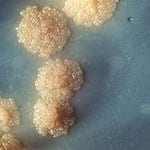 Scientists at the Forsyth Institute have gained new insight on how Tuberculosis (TB) remains a global epidemic. Although drugs have been available to fight TB for decades, the disease still infects nearly 2.2 billion people worldwide and causes 1.7 million annual deaths. This is largely attributed to the bacteria’s ability to stay dormant in the human body and later resurface as active disease.
Scientists at the Forsyth Institute have gained new insight on how Tuberculosis (TB) remains a global epidemic. Although drugs have been available to fight TB for decades, the disease still infects nearly 2.2 billion people worldwide and causes 1.7 million annual deaths. This is largely attributed to the bacteria’s ability to stay dormant in the human body and later resurface as active disease.
The Forsyth team, with collaborators from Stanford University, has recently discovered that Mycobacterium tuberculosis, the bacteria that causes TB, can lay dormant and thrive within bone marrow stem cells.
The microbe Mycobacterium tuberculosis (Mtb) causes deadly disease in millions of humans and infects and persists in billions of others without causing apparent harm, yet maintaining the potential to “re-activate” and cause active tuberculosis (TB). During this phase, Mtb escapes the host immune responses and survives for decades in protected niches not yet well identified.
The research describes a previously unsuspected bone marrow (BM) stem cells used by Mtb to shield itself from the host immune system. These cells constitute a unique niche or a sanctuary that provides the pathogen both immune privilege and protection from drug attack. Stem cells, like those infected by Mtb, are long living cells and possess a special machinery to exclude external molecules such as anti-TB drugs to enter their cytoplasm. Once inside such cells, Mtb benefits from these unique mechanisms for its survival.
“These new findings have direct clinical implications in that they explain the reason why TB treated patients remain sensitive to TB tests for life and importantly, why TB treatment is so difficult and requires long periods of drug treatment,” states the Forsyth research summary. “Moreover, these findings raise an alert for possible transmission of TB to patients undergoing bone marrow transplants with cells obtained from donors who may have latent TB.”
This study was funding in part by grants from National Institute of Allergy and Infectious Diseases (NIAID).
Source: Forsyth Institute

